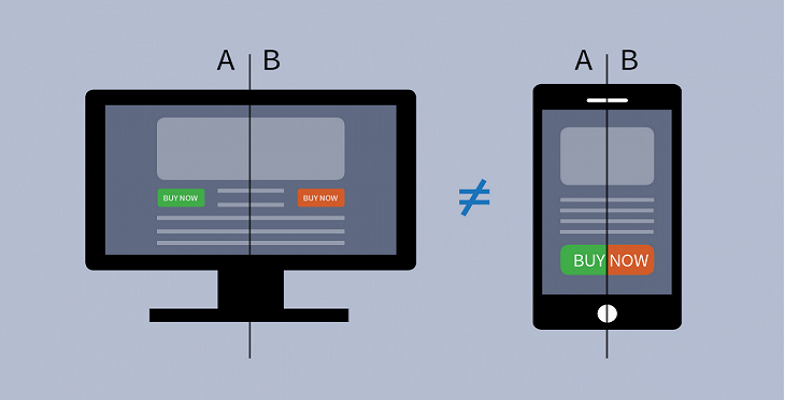Radikally Different - Our World View

Why is Usability Testing Important For Mobile And Web Applications?
Usability testing is an integral part of Software testing. “Application Under Test” or AUT is a complex process in usability testing as user expectations and requirements are assessed. With mobile and web applications being a rage of the present times it is becoming extremely important for testers to conduct usability testing on software/application products. This helps in rethinking on structures and designs.
What is Usability testing?
Usability is a multi-dimension feature that deals with a user’s experience with apps and their feelings towards it. Interaction with an app makes the user go through various experiences and feelings. Usability testing is a well-structured assessment of this experience into a proper a validation process.
Some of the most fundamental points of usability testing are – Design layout, login details, reports and gauging the significance of business needs.
Who can perform usability testing?
A developmental setup comprising of developers, testers and designers works together in analyzing the system and bringing out results. These results are important in gauging design implementations and codes. Assessments lead to actions taken for modifications in code and design elements (as and when required). Agreements are reached by all parties to implement changes wherever they are required.
There are high-end usability testing efforts taken by some organizations that include hiring of real-time users who are asked to perform certain tasks. An appointed facilitator assesses these tasks and the results. The users are often asked to provide relevant information on areas like:
- Whether the task was successful or not
- How was the overall experience? Was it an interesting and engaging experience or a complete disappointment?
- What was their feeling towards the application/software?
- Whether the tasks given to them were performed easily or did they involve strife?
Why is Usability Testing carried out?
There are millions of mobile and web applications running in the market. With each passing day the numbers of apps are increasing enormously. Business world is taken over by the app storm. With more number of apps being launched the need for application testing increases considerably. It is important that web and mobile apps turn out to be as easy, appealing, effective, engaging, simple and efficient as they are desired to be. In order to ensure their high-end performance it is critical to perform usability testing. Engaging customers into this testing process is also very important. The main aim is to determine whether the user wants to come back to the website or continue using the app.
This process involves not just software systems and applications, but any interface and platform that involve human interaction. All machines, apps and system interfaces need to satisfy users. For example electronic voting machines that require only a click of a button. The machine should give out error-free output. One click determines a huge socio-political impact.
When does Usability Testing Need to be Incorporated?
Testers will vie for the fact that the sooner a malfunction is detected the better it is to fix it. Usability Testing is performed in the initial stages of development. The results produced by UT greatly impact a product’s design implementations. Design changes must be suitably carried out in the initial stages.
Coding and programming changes are also required based on usability results. It has been suggested by industry experts that usability testing should be carried out at regular intervals to attain maximum results.
Ways to Conduct Usability Testing
Usability testing is a form of testing the user’s mental map on his/her liking towards an application/website/machinery validation. It is more like a user experience tester. Here are some of the standard ways it is carried out:
Type 1
Before a design is all set to be made, drawing it out on a piece of paper and analyzing how good it is going to work is a way of UT in the design phase.
Type 2
Random tests can be included after during a website is being developed. This is an exploratory method where internal design/QA/development teams perform random tests that bring out results which are used to validate usability factors.
Type 3
Real-time users are hired to access and navigate the website before reporting results.
Type 4
Submitted designs and wireframes can be assessed with tools that provide statistics based on the inputs of the former.
Type 5
A third party UT team or an external evaluator can be hired to carry out the standard testing procedures and make way for internal improvements. Results based on design and wireframes can be submitted for future changes.
Read Also: Leading Mobile App Testing Tools
What are Methods of Usability Tests?
Identifying Problems
Discovering problems in usability tests is one of the most popular forms of usability studies. Main aim is to identify real problems and fix them. Participants carry out tasks that bring out common issues. UX or user experience is a wide field that involves in-depth research. Problem discovery studies help UX researchers to carry out effective product development.
There are moderated and un-moderated formative approaches involved in problem discoveries. Evaluations are used to make corrections in interfaces.
Benchmark Study
Finding problems and creating making changes in design does not solve the problem. The question remains as to the fact that whether the design changes make the interface easier to use or not. Benchmark studies are considered summative studies. Historical data is collected and assessed in order to gauge the impact of design changes. Standardized tests form an integral part of benchmark studies which is again a part of UX research.
Comparative Studies
Benchmark data provides a lot of information on tasks and experiences. However comparison of benchmarks leads to a deep understanding of success rates for various ranges of products. Same set of tasks carried out on different services and websites by different set of individuals provide a comparative study. Errors in task scenarios and testing metrics are common. Application testing finds it important to get over with these errors. Comparative study on previous designs makes way for contextual UT.
Differences in approach can be found with the help of large sized samples. Comparative studies of benchmarks often undergo longer time, more dedicated individuals and un-moderated remote approach.
Eye-tracking studies
It is important to asses and understands the way participants view the designs. Gaze paths must be studied well. Eye tracking is required. It has been often witnessed how a user’s look differs from his/her click. Eye-tracking is a time consuming procedure which can be conducted on multiple devices. Application testing done for desktops, Smartphone and tablets can benefit greatly from eye-tracking UT method.
Quantifying the Learning Process
Participants repeatedly taking part in tasks quantify the learning curve. Repeated tasks are beneficial as they are able to determine problems in UX and impressions. Participants encountering problems even after repeated performances receive substantial evidence for immediate changes and error fixes.
Usability Testing is a broad area of testing that requires in-depth understanding of the field and its expanse. UT being an open-end solution has space for creativity in suggestions, observations and skills.
-
John Weidner
- Augmented Reality (4)
- Enterprise (9)
- Games (15)
- Marketing (17)
- Mobile App Development (26)
- Mobile Apps (19)
- Mobility Solutions (1)
- Monetization (8)
- News (16)
- Remote Hiring (1)
- Strategy (13)
- Testing (7)
- Uncategorized (1)
- User Experience (8)
- Virtual Reality (4)
- Web Browsing (1)
- Web Design & Development (20)
